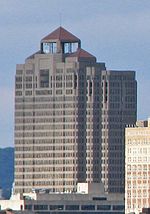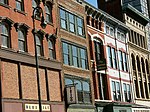Richard C. Lee United States Courthouse
1912 establishments in ConnecticutBuildings and structures in New Haven, ConnecticutCourthouses in ConnecticutFederal courthouses in the United StatesGovernment buildings completed in 1912 ... and 1 more
National Register of Historic Places in New Haven, Connecticut

The Richard C. Lee United States Courthouse is a monumental courthouse of the United States District Court for the District of Connecticut, located on the east side of the New Haven Green. Built between 1913 and 1919, the structure was spared from a planned demolition in the 1960s, and instead renovated to continue its useful life. For many decades, it also served as a post office, although the post office moved to another location in 1979. It is an excellent example of Classical Revival architecture. It was listed on the National Register of Historic Places in 2015.
Excerpt from the Wikipedia article Richard C. Lee United States Courthouse (License: CC BY-SA 3.0, Authors, Images).Richard C. Lee United States Courthouse
Church Street, New Haven
Geographical coordinates (GPS) Address Nearby Places Show on map
Geographical coordinates (GPS)
| Latitude | Longitude |
|---|---|
| N 41.306666666667 ° | E -72.925 ° |
Address
Church Street
06510 New Haven
Connecticut, United States
Open on Google Maps








